If you've ever wandered through a city you might have noticed tiny 5G cell towers on street light poles. They appear like tiny boxes, but they're actually broadcasting wireless signals from mobile providers to your phone.
They are replacing larger, purpose-built cell towers. While they're not as noticeable however, they could cause problems for people.
A Federal Communications Commission's Radiation Exposure Thresholds
The FCC's Radiation Exposure Thresholds establish the safe distance that an individual can be exposed to electromagnetic radiation from wireless devices. The limits for exposure are based upon scientific research that prove that electromagnetic energy can cause harm to health.
The absorption rate specific (SAR) is an indication of the radiofrequency energy taken up by tissues. It's usually 1.6 watts per kilogram, averaged over one kilogram of tissue.
But, since 5g operates at higher frequencies this could be able to create more energy on the skin as well as other body parts. This can lead to various possible harms, like the appearance of skin conditions like dermatitis, cataracts, and skin cancer.
Due to the possible harmful effects of radiation from 5G, PSU has chosen to set a general localized maximum power density of four mW/cm2 measured across 1 centimeter, but not to exceed 30 minutes, for the entire 5G spectrum at 3000 GHz. This localized limit is consistent with the highest spatial-average SAR of 1.6 W/kg, which is averaged over 1 5 grams of body tissue, at 6 GHz.
The FCC's Maximum Exposure Thresholds for Maximum Exposure
If you've ever used a cell phone, you probably know that the safest distance from the tower should be at least 400 meters away. This is due to the power of the transmission of the cell tower is significantly increased the farther the tower is.
While this sounds like an ideal idea, the reality is that those living close to towers might be more prone to health problems. For instance, a 2014 study in India found that residents who lived within 50m of cell towers had significant more health issues than those who lived farther distance from them.

But, the study revealed that those who relocated to areas further away from cell towers noticed their symptoms improve within a couple of days. Other studies have shown that exposure to high amounts of electromagnetic field radiofrequency (EMFs) could cause cancer, brain tumors as well as other health issues.
what is safe distance from 5g tower is because RF radiation, which is utilized in wireless communications, may penetrate the body's outer layer, the skin. It is crucial to know because the skin acts as a protective barrier against injury to the body, infection by pathogenic microorganisms, and the entry of harmful substances. The skin is the largest organ of the human body and is accountable for keeping the integrity of the other organs.
The FCC's Minimum Exposure Thresholds
The FCC's Minimum Exposition Thresholds depend on a variety of assumptions that are not supported by scientific research. These include the erroneous assumption that exposures to RF radiation are safe due to minimal absorption into body (i.e. the heating of tissues).
The assumption is also ignoring the deeper penetration of the ELF elements of modulated radio signals and the consequences of brief bursts of heat caused by RF pulses. These theories are not compatible with the current understanding of biological consequences of RF radiation. Therefore they should not be used for health protective exposure standards.
Additionally there is the fact that both ICNIRP and FCC are limiting their radiation limits for local peak SARs that are based on the peak speed of spatial absorption (psSAR) which is not a sufficient dosimetric tool to assess the amount of exposure to RF radiation. Particularly, psSAR is inaccurate when frequencies exceed 6 GHz. Furthermore, psSAR has not been tested for RF radiation that is exposed to other environmental agents such like sunlight. In the event of interactions, RF radiation with other environmental agents may cause synergistic or antagonistic effects. what is a safe distance from a 5g cell tower would result in an increased risk of negative health consequences. For Hop over to this website , co-exposure to RF radiation and sunlight could increase the risk of skin cancer and exacerbate other skin conditions like acne.
